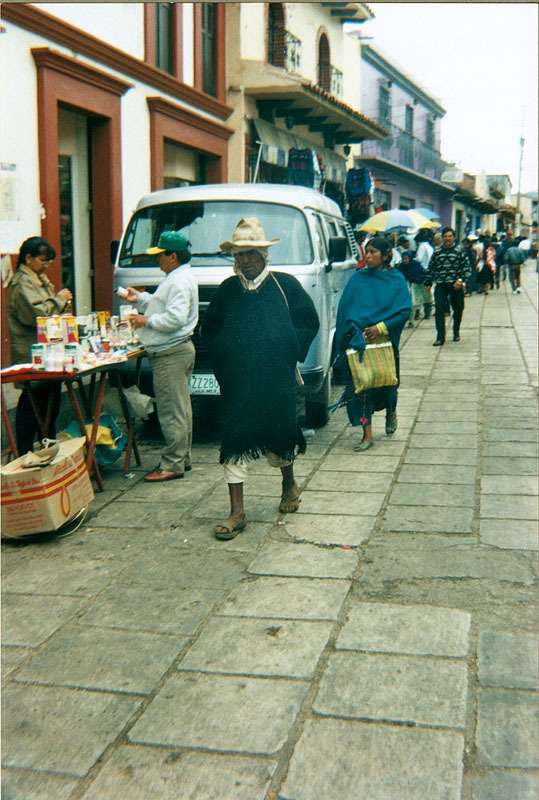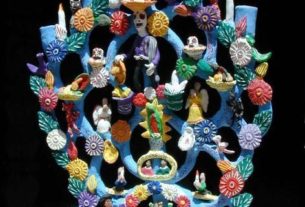High in the mountain cloud forest of Chiapas, nestled within a bowl of hills, lies the ancient Colonial city of San Cristobal de Las Casas. For some 500 years it has pursued its own destiny, isolated from the world as if on a different planet.
Through the ages, it has retained its distinctive Spanish Colonial ambiance, a small sleepy town moving at the pace of the donkeys that deliver fresh milk from canisters slung on their sides, or piled high with firewood bundles. They plod down the narrow cobblestone streets, the width determined to allow two armored Conquistadores to pass abreast. The staccato click of their hooves against the stones echoes down from the past.

The powder-blue of the sky is the color of a baby boy’s blanket, and the billowing fleece of the clouds collides with the surrounding foothills. The encompassing peaks are mostly denuded of the native forests, victims of the cities’ appetite for the warmth that the firewood delivers there in the coldness of the night.
That also accounts for the smell of burning wood that overlays the city. While burning is the smell of the city, the ubiquitous explosion of rockets is very much a part of the sound of the city. Rockets are used here for every occasion, and often when there is no real occasion. The multiple explosions often terrify skittish tourists, those who are always expecting an attack by the Zapatistas.
It is a little difficult to estimate the population of the town and its surrounds, and approximates running from 35,000 to 250,000 are seen because of the fluid population, but 250,000 feels about right.
There are three cities here, barely co-existing side-by-side. There is the tourist city with all its attractions. There is the daily monotony of the everyday life of the townspeople, and then there is the grinding poverty of Los Indios, who live on the outskirts, surrounding the city as if on the attack.
The tourist San Cristobal is only a small part of the town, running from the central town square south to the bus station, north to the Church, and then east along the Real de Guadelupe to the Templo of The Virgen de Guadalupe. There is so much more that they miss.
The tourist San Cristobal de Las Casas includes the majestic Cathedral on the square, and it is an impressive gilded achievement dating from the fortified beginnings of the garrison town.The Cathedral is occupied 24/7 by pious parched and shriveled Indian women, barefoot and wrapped in threadbare Indian cloths, crawling the length of the nave on their knees, pleading with the larger than life suffering gesso Jesus hanging above the baroque red velvet elegance of the raised altar platform. Picturesque beyond belief.
But they would miss the real story. The real story is Bishop Sam Ruiz, the pastor of this magnificent church who fights for the Rights of his Indian flock against all odds, a man who is as courageous in his way as Bartolomeo de Las Casas was in the 16th Century when he was the first Bishop of Chiapas.
The tourists will climb myriad steps to the Church of the Virgen de Guadalupe impressively perched on a high hill overlooking the town and they will be awed by the panorama as seen from the hill.
They too would miss the real story. They would miss the Fiesta of the Virgen de Guadalupe, where the church high on the hill is the centrepiece. They would miss the parade down the main street with the rockets fired into the sky. They would miss the gaily-lighted booths and the carnival rides lining the street going up to the church. They would miss the nighttime crowds, all holding candles, that fill the streets and the staircase to the church, making your throat catch with the pageantry.
The tourists will see the town square surrounded by the City Hall, the Cathedral, and several hotels, and it is charming, but they will miss demonstrations of the Zapatistas.
They will miss seeing the men in black ski masks and the women with their faces covered with scarves, crowded into the square to listen to the impossibly young and naive rabble-rousers that have traveled all the way from the National University of Mexico (UNAM) in Mexico City, to stir up the Indians. The tourists will also miss the lines of riot-equipped police waiting nervously in the shadows of the colonnades of the City Hall, holding their assault rifles, watching for the surge of a hostile crowd toward them.
The tourists may go as far north as the Templo de Santo Tomas, an interesting enough church, as churches go, but they will likely miss the museum in back of the church, the museum that occupies the barracks surrounding the inner parade ground that was built when the city was founded, and is now a garden courtyard. They will miss the peace of that ancient courtyard, and never see the pigeons darting from tower to tower, framed in the open square of moldering stucco buildings.
If they had gone a little further north, they would soon have come to the market that is open each day except Sunday, when the surrounding towns have their own markets, and the vendors are there. The market is centered on a large building that is only a part of the market, and is mostly filled with butcher shops displaying bloody beef, pork, and poultry parts, many with a light dusting of flies.
The market extends over many blocks filled with booths selling anything that one might want. There are gringo turistas at the market, mostly European backpackers, and their large bodies contrast with the tiny Maya, as the foreign giants walk stooped over and with heads sideways, avoiding the colorful plastic tarpaulins strung between booths on both sides of the street to provide shade.
Amber is the hot product in San Cristobal de Las Casas , and you can find it everywhere, with or without embedded prehistoric insects. People sidle up to you in the streets to offer jewelry of amber, but it is often only colored plastic. The only way to tell the difference is to burn an edge, the amber burning has a sweet honey smell, while burning plastic has the acrid odor that is familiar to everybody.
There aren’t many tourists at the Templo de San Cristobal, reached only by a veritable mountain of stairs only to discover that the Church is often closed, the only reward being the fantastic vistas of the red-tile roofs and towers of the city, and the peaks that surround it.
Few tourists ever see the Templo de El Merced, which may be the earliest Church built in the city, and is a piece of living history, speaking of a time when the Churches were actually fortresses, places where the soldiers were quartered, and places where the citizens could retreat if under attack.
The entrance is a massively daunting wooden door with wrought iron hinges and fastenings. There are very few windows piercing the thick solid walls, and even those are built as loopholes for those firing muskets from inside to repel attackers. The entire structure is built with extensions and abutments to provide for interlocking fields of fire. The only disappointment is that entry to the fortifications is denied as too dangerous.
Tourists also get only a partial picture of the knock-down traveling carnival that makes the rounds of all the 22 major churches, occupying the church patios as fundraisers on a rotating schedule. Set up overnight, and disappearing overnight.
Las Grutas de San Cristobal, the local caves, are too far outside the town, and too hard to get to, or even to realize they exist. They get few visitors in spite of the fact that it is a tourist-friendly site, with lighting, walkways and railings that extend half a mile inside the caves.
The Easter festival of Semana Santa is worth the trip by itself. There is a dramatic re-enactment of the crucifixion performed in an open-air plaza, and then later, once it turns dark, there is the Burning of Judas.
In the patio behind the City Hall, individuals and organizations fabricate large flammable constructions of their own pet hates, filled with fireworks. Government bureaucrats, Church officials, recognizable politicians, the Army, the United States, Monica Lewinsky, a Spanish Conquistadore, and, of course, Judas.
It started as a community expression of hatred for the Biblical betrayer, but it has grown to embrace almost anything that can be depicted. In fact, it may well be the only real expression of Freedom of Speech in Mexico.
The constructions are touched off by the local bomberos, the firemen, and they make a show of shooing the crowds back from the furiously burning statues, but it isn’t like the US, where the citizens are kept back 300 feet. Here, the fireworks are going off at their feet, showering them with sparks, choking them with smoke, here everybody is a participant, and the kids take turns running at the fiery cartoons, waiting to be chased by the good-natured bomberos.
Semana Santa is also a time of processions, silent or singing marchers, looking like KKK members in their pointed hoods carrying heavy swaying platforms topped with religious figures. They go from home to home, stopping at those homes that have erected small shrines. There they say prayers and bless the house and its occupants before moving on. They finally come to rest in a gigantic open house where an inner shrine has been erected lit by thousands of candles, and potluck tables groan with the many foods of Mexico. Everyone is invited, even strangers passing by on the streets.
San Cristobal de Las Casas is more than places and things. Most of all it is the people. The Indian women who walk barefoot in the streets, a seeming indictment until the first monsoon rain. It is then that the sidewalk curbs two feet above the road level make sense.
They are built that high because the runoff comes down the street in overflowing rapids stirred up by the cobblestone roadways. The intersections and plazas are filled with knee-deep lakes. It is then that the wisdom of going barefoot emerges, because shoes or even boots, simply become containers for the water that is everywhere you care to walk.
San Cristobal is the dirty-faced undernourished Maya urchins that come at you in packs, begging tourists to buy their Chiclets or Munecas, their handmade dolls, or the old women sitting on the street corners, selling roasted peanuts, cacahuates, or meager goods displayed on a small cloth spread out on the sidewalk.
It is the little old men, dressed in rubber-tire sandals, wearing white cotton pants and guayabera, stooped over and plodding down the road with an enormous load on his back, secured by a tumpline across his forehead.
It is the canny little Maya women, bargaining for all they are worth as they sell their wares in the marketplace, or walk through the thronged streets with a live turkey backwards under their arm, the bird grumbling uncomfortably as it goes to its death.
It is a tiny little girl, eight or ten years old, lying on the sidewalk, in front of her a pile of little packages of beans, or a few limes, maybe a couple of apples, as she tries to supplement her families’ income.
Don’t miss the town plaza in front of the City Hall at night when the boys and girls promenade past each other in opposite directions around the gazebo.
Do
This hardly even touches the surface of this wonderful town. There isn’t time here for a discussion of Na Bolom; or of the French restaurant on Calle Francisco Madero; of El Puente (the bridge) on Real de Guadelupe, which is an Internet Café, a gringo hangout, a coffee place, a place for Spanish lessons, with or without the immersion Spanish experience) and a movie theater all-in-one (say Hi to Roberto); the Internet Café in the pass-through from Real de Guadalupe to Calle Francisco Madero; the new Domino’s Pizza that is a runaway success, the deluxe Bus Station; Moxviquil; the Casa de Pan, a kind of bakery and breakfast place owned by Americans and on a wonderful little sunlit plaza that should be seen at sunrise; the ‘Grito’ on the Zocalo; oh so many places, people and things.
It’s hard for a tourist to get more than a taste of a place even in a week or two, but San Cristobal deserves more. It needs more because there is so much more there. It is a magical place, and people come from all over the world to see it and be in it. Many never leave.


